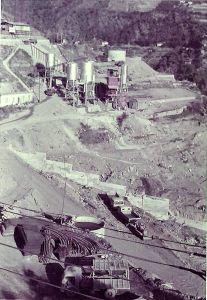Post-war until 1959
In 1945 the town of Sanremo had about 30,000 inhabitants. Its main sources of wealth were in very poor condition: the Casino closed, the export of flowers blocked by the interruption of roads and railways, tourism non-existent.
Many hotels were damaged either by bombs or by the various armies that had requisitioned them.
The first and only post-war tourist was the Italo-American millionaire Acquavella who, to the amazement of the people of Sanremo, landed in the harbour mirror with his amphibian "Seabee".
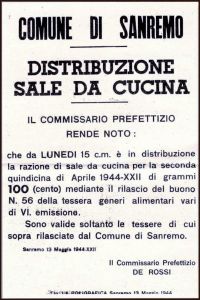
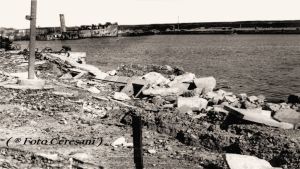 The income was miserable, with the ration card you were entitled to an eighth of bread per person, electricity and water were provided only a few hours a day, and there was no gas at all.
The income was miserable, with the ration card you were entitled to an eighth of bread per person, electricity and water were provided only a few hours a day, and there was no gas at all.
After two years of continuous aerial and naval bombardment, the building heritage of Sanremo was seriously damaged.
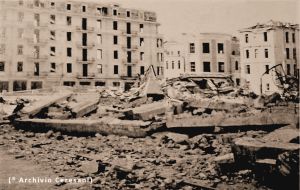 In particular, the Port area, downstream from Via Roma, the centre of La Pigna and the area of Piazza Colombo, destroyed on 20 October 1944 by the
In particular, the Port area, downstream from Via Roma, the centre of La Pigna and the area of Piazza Colombo, destroyed on 20 October 1944 by the 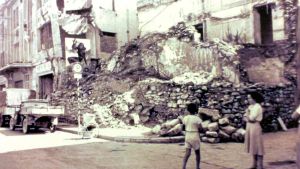 huge explosion of the building that included the Law Courts, the Casa del Fascio and the Flower Market, in which 48 German "Linsen" explosive boats were housed, suffered extensive demolition.
huge explosion of the building that included the Law Courts, the Casa del Fascio and the Flower Market, in which 48 German "Linsen" explosive boats were housed, suffered extensive demolition.
Minor damage was caused throughout the town.
In October 1945, the Siffredi Council, appointed by the Sanremo CLN, decided to return the gambling business, temporarily housed in the halls of the Hotel Vittoria Roma, to its natural home, the Casino, closed since June 1940.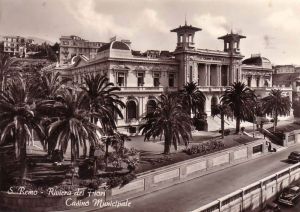
In order to settle the question of the form of management to be adopted for the casino, the council appointed a commission to decide on the matter, which was set up in November 1945. In the meantime, in view of the forthcoming reopening of the Casino, scheduled for 31 December 1945, a call for tenders was made, in which nine companies took part, among which that of accountant Placido Gandini was to be chosen. However, as accountant Gandini was unable to fulfil his contractual obligations, on the evening of 28 December, the mayor declared Gandini's company out of business and entrusted the management of the games to Cirt (Compagnia Italiana di Ricostruzione Turismo).
On New Year's Eve 1945, the casino reopened under new management.
On 24 March 1946, the first free administrative elections were held, after which engineer Eugenio Bottini was elected mayor.
Bottini's administration was mainly concerned with removing the rubble of the recent war, demolishing unsafe buildings and repairing roads damaged by bombing. 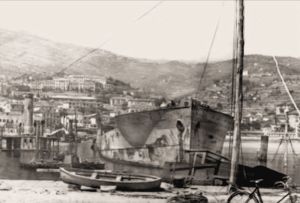 It was also necessary to clear the harbour basin of numerous sunken boats, together with a large stone-laden ship that was blocking the entrance to the harbour, specifically to prevent enemy incursions.
It was also necessary to clear the harbour basin of numerous sunken boats, together with a large stone-laden ship that was blocking the entrance to the harbour, specifically to prevent enemy incursions. 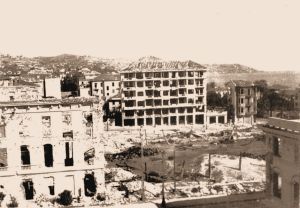 The first interventions were to clear the rubble and repair the war damage. In Piazza Colombo, the enormous mass of debris from the Flower Market was dug up, first by hand, with the help of the citizens who organised free "corvees", then with the help of one of the marvels brought by the American Army: the first bulldozer, consisting of an armoured cart equipped with a ploughshare, which in one day did the work of a team of men for a week.
The first interventions were to clear the rubble and repair the war damage. In Piazza Colombo, the enormous mass of debris from the Flower Market was dug up, first by hand, with the help of the citizens who organised free "corvees", then with the help of one of the marvels brought by the American Army: the first bulldozer, consisting of an armoured cart equipped with a ploughshare, which in one day did the work of a team of men for a week.
The first public works, other than mere reconstruction, were the demolition of the curtain of houses that still enclosed Piazza del Mercato to the north, blocking vehicular access to Via Martiri della Libertà.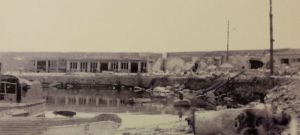 The work was carried out by hand, the cement was that taken from the Germans of the TODT during the construction of the Anti-Board Wall that still runs along Corso Trento e Trieste; for the iron, sometimes straightened reticulated rods were used, the sand was dug out of the sea by a boat with a suction pump and washed summarily on the quay. Scaffolding was made from old wooden planks and triestini nailed together and tied with ropes.
The work was carried out by hand, the cement was that taken from the Germans of the TODT during the construction of the Anti-Board Wall that still runs along Corso Trento e Trieste; for the iron, sometimes straightened reticulated rods were used, the sand was dug out of the sea by a boat with a suction pump and washed summarily on the quay. Scaffolding was made from old wooden planks and triestini nailed together and tied with ropes.
In addition to restoring the city centre, the port was also given the task of resuming its activities, as well as clearing the water of wrecks, and repairing the damage on land, on the piers and in the adjoining buildings.
In anticipation of a greater commitment on the part of the Maritime Authorities, it was decided to build a new and larger Harbour Master's Office, which was inaugurated in 1949 and 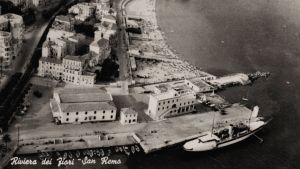
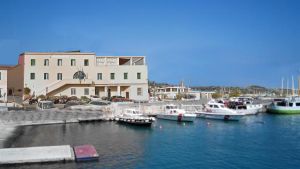 inaugurated in March 1950. The Municipal Administration entrusted Angelo Salvadori's company with the work, directed by engineer Michele Savalli, for the construction of the building in the large square in front of the port area, which cost the Treasury the sum of 14,131,639 lire.
inaugurated in March 1950. The Municipal Administration entrusted Angelo Salvadori's company with the work, directed by engineer Michele Savalli, for the construction of the building in the large square in front of the port area, which cost the Treasury the sum of 14,131,639 lire.
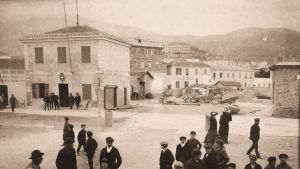
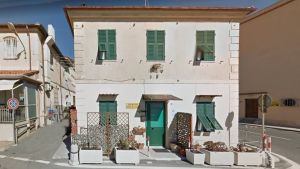 When the work was completed, the old harbourmaster's office, built in 1880 and housing the commander's house, should have been demolished, as it was an obstacle to traffic between Via Nazario Sauro and Via Arenella. However, despite Mayor Siffredi's requests to the Port Authorities, the Prefecture and the Civil Engineers, the harbourmaster's office was never demolished and still stands today.
When the work was completed, the old harbourmaster's office, built in 1880 and housing the commander's house, should have been demolished, as it was an obstacle to traffic between Via Nazario Sauro and Via Arenella. However, despite Mayor Siffredi's requests to the Port Authorities, the Prefecture and the Civil Engineers, the harbourmaster's office was never demolished and still stands today.
The hotels were repaired, including the Royal, which was renovated and enlarged by its owner, Mario Berolini. The construction of the splendid swimming pool was undertaken to a design by Gio' Ponti.
Mayor Bottini also commissioned a group of engineers and architects from Sanremo, led by engineer Bartolomeo Corradi, to draw up a town planning scheme, which was completed at the end of 1947, and which provided for the railway line to be moved upstream, thus restricting the disorderly construction of the new buildings that were beginning to rise along the coast.
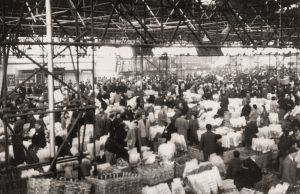 During 1947 the new flower market was inaugurated in Corso Garibaldi, next to the Church of the Angels. The new flower market occupied an area of
During 1947 the new flower market was inaugurated in Corso Garibaldi, next to the Church of the Angels. The new flower market occupied an area of 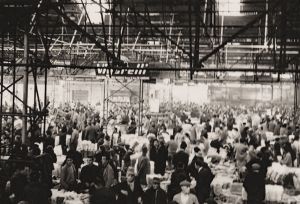 7,200 square metres, of which 6,000 were used for the trading area and 1,200 for offices and various services. The actual area available for placing the flower baskets on the ground amounted to 4,400 square metres, allowing for the placement of approximately 1,500 baskets.
7,200 square metres, of which 6,000 were used for the trading area and 1,200 for offices and various services. The actual area available for placing the flower baskets on the ground amounted to 4,400 square metres, allowing for the placement of approximately 1,500 baskets.
The market could be accessed through three entrances: Corso Garibaldi, Via Marsaglia and Via Volta. The structure also contained all the institutional and private services needed to carry out agricultural and commercial activities, but did not have its own car park, so that the thousands of flower growers and traders were forced to park their vehicles in the adjacent streets, which were also insufficient to 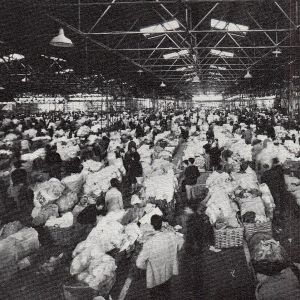 accommodate all the vehicles flowing into the trading area.
accommodate all the vehicles flowing into the trading area.
On the busiest days, the number of vehicles going to the Corso Garibaldi market at peak times was estimated at around 2,000, with no more than 300 parking spaces available in the car parks located in the immediate vicinity of the trading hall.
In the meantime, one year after his election, Mayor Bottini was the victim of an authentic coup d'état by the majority councillors, who wanted to prevent the Council from granting the management of the Casino to another company, since the shareholders of CIRT were going through a particularly difficult period due to a series of financial and administrative problems.
In April 1947 Bottini was therefore forced to resign and in May his place was taken by the Christian Democrat lawyer Paolo Manuel Gismondi.
In the meantime, CIRT had requested and obtained a conservative seizure of the Municipality's assets for 400 million lire, after the Ministry of the Interior had ordered the Municipal Administration to oust two of CIRT's shareholders, Leoni and Soldaini, from the management of the Casino for "delicate reasons"; the latter would commit suicide shortly afterwards in a hotel in Monte Carlo.
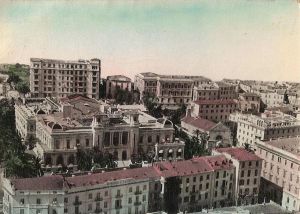 The following December, all the other CIRT shareholders were also liquidated by Giovanni Luca, who, having become the last shareholder, was also ousted from the management of the Casino "for reasons of public order" by government order.
The following December, all the other CIRT shareholders were also liquidated by Giovanni Luca, who, having become the last shareholder, was also ousted from the management of the Casino "for reasons of public order" by government order.
Luca was thus forced to pay out of his own pocket the costs of two years of management of his now bankrupt company, paying the astronomical sum of 350 million.
On 29 December 1947 the Municipality renewed the contract for the Casino with CIT, (Compagnia Italiana Turismo), the new concessionaire that had taken over from the bankrupt CIRT.
On 25 February 1948 the Prefect Amedeo Salé was nominated extraordinary commissioner of the Casino, who would have managed the Sanremo Casino with great competence and professionalism, allowing it a considerable increase in revenue; later the old concessionaire CIRT, excluded from the management of the Casino, asked the Municipal Administration for a billion in damages, which would not be paid.
In view of the political elections scheduled for spring, the Democratic Front was also set up in Sanremo, whose presiding bureau included Dr Agosti, Professor Mario Calvino, Mrs Giuseppina Cristel, Dr Marco Donzella, engineer Tullio Graf and the well-known partisan exponent Vittorio Guglielmo, while the executive committee included the floricultural exporter Eugenio Kahnemann, Professor Mario Mascia, Mario Baggioli and Gino Napolitano, who was already a municipal councillor.
The political elections of 18 April 1948, however, saw a clear victory for the Christian Democrats, who also achieved a good result in Sanremo with the election of the Christian Democrat mayor of the city, Paolo Manuel Gismondi, as a deputy.
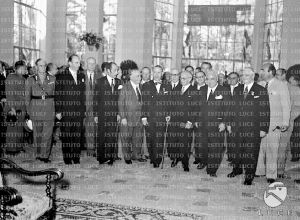
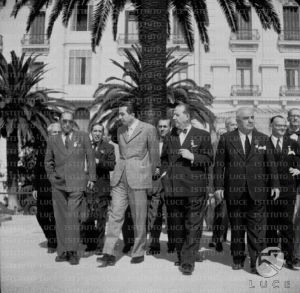 From 24 to 30 September 1948, the second Congress of the Italian Press (FNSI) was held in the pavilion of Villa Ormond, with the participation of the undersecretary to the Prime Minister Giulio Andreotti, who also visited the headquarters of the Azienda Autonoma di Soggiorno e Turismo, the President of the Republic Luigi Einaudi, and the Honourable Members Facchinetti, Azzarita and Tambroni (photo Istituto Luce).
From 24 to 30 September 1948, the second Congress of the Italian Press (FNSI) was held in the pavilion of Villa Ormond, with the participation of the undersecretary to the Prime Minister Giulio Andreotti, who also visited the headquarters of the Azienda Autonoma di Soggiorno e Turismo, the President of the Republic Luigi Einaudi, and the Honourable Members Facchinetti, Azzarita and Tambroni (photo Istituto Luce).
Also in September 1948, engineer Corradi presented the City Council with an innovative project for a tourist harbour, which envisaged the construction of a dry dock in the area where the Canottieri Society was located and a breakwater in front of the same Society with a hammerhead oriented towards the inside of the harbour, the extension of the breakwater for about 50 metres towards the San Martino shore, the construction of a quay reserved for fishing boats along the last stretch of the western pier, the quaying of the entire Pian di Nave area and the construction of a 225-metre-long breakwater to protect the basin from easterly winds, particularly the grecale. Despite the approval of many councillors and ordinary citizens, this project, whose total cost was estimated at 895,250,000 lire, was not carried out, remaining only on paper.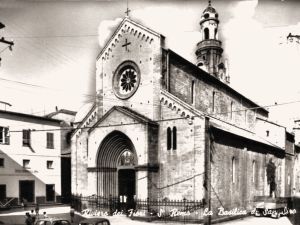 On 2 October 1948 Pope Pius XII elevated the church of San Siro to the status of Basilica, while in the same period the first five council houses were inaugurated in the Borgo district and work continued apace on the construction of the new Valle Arma cemetery, which had become indispensable because the Foce cemetery was now insufficient to hold all the city's dead.
On 2 October 1948 Pope Pius XII elevated the church of San Siro to the status of Basilica, while in the same period the first five council houses were inaugurated in the Borgo district and work continued apace on the construction of the new Valle Arma cemetery, which had become indispensable because the Foce cemetery was now insufficient to hold all the city's dead.
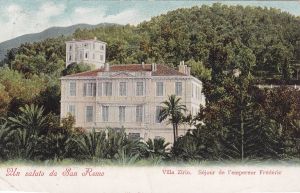 In January 1949, the Municipality purchased Villa Zirio and the garden in front of it from the Italian government for 35 million lire. It was to become the seat of detached municipal offices.
In January 1949, the Municipality purchased Villa Zirio and the garden in front of it from the Italian government for 35 million lire. It was to become the seat of detached municipal offices.
In the meantime, the Municipal Council resumed its examination of the Casino issue, studying in particular the possibility of calling a new tender, despite the firm opposition to this solution by the President of the Tourist Board, Nino Bobba, who was in favour of direct management of the Casino by the Municipality.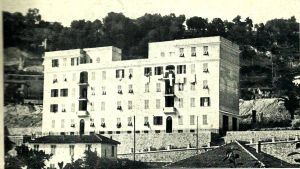
During this period, the Council also approved the regulations for the assignment of the first council houses built in Via Dante Alighieri and the project for a fruit and vegetable market, to be built in the area between the San Romolo stream and Piazza Eroi Sanremesi, while the new town cemetery was inaugurated in Valle Armea.
On 24 September 1949, however, there was a change in the city's political situation caused by the resignation of the three communist councillors of the Gismondi Council, who were promptly replaced. In the following December, the Council approved the project for the reconstruction of the Principe Amedeo Theatre, which remained unimplemented, while in the same period the new schools in the hamlet of Poggio were inaugurated.
At the end of 1949 the tender for the management of the Casino, called by the Municipal Administration at the beginning of the year, came to an end. It was won by Commendator Pier Busseti, who agreed to grant the Municipality 81.70% of the gross receipts, reserving for himself the remaining percentage plus all personnel expenses.
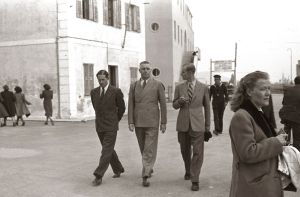 On 31st December 1949 the Cinema Teatro Astra was finally inaugurated, a new structure with 1,200 seats; during the inauguration a show was held, the proceeds of which were then donated to the war disabled, which included a vocal and instrumental concert conducted by Giovanni Sartorio and the screening of the film "Notte e dì".
On 31st December 1949 the Cinema Teatro Astra was finally inaugurated, a new structure with 1,200 seats; during the inauguration a show was held, the proceeds of which were then donated to the war disabled, which included a vocal and instrumental concert conducted by Giovanni Sartorio and the screening of the film "Notte e dì".
It was also attended by Prince Philip of Edinburgh, consort of the future Queen of England Elizabeth II, who arrived in San Remo on board the Royal Navy Destroyer Chequers.
In January 1950, the City Council entrusted the architect Camus and the engineer Santagostino with the project for the redevelopment of Piazza Colombo and decided to allow cars to park only on the left side of Via Matteotti.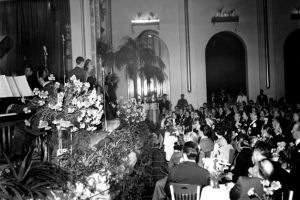
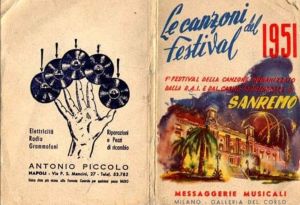 At 10 p.m. on January 29, 1951, in a crowded ballroom of the Municipal Casino, the first edition of the song festival took place. It was the result of the untiring activity of Amilcare Rambaldi, who had finally managed to convince the Director of the Press, Tourism and Events Office of the Casino, Angelo Nizza, to make his dream of organizing an Italian song festival in Sanremo come true.
At 10 p.m. on January 29, 1951, in a crowded ballroom of the Municipal Casino, the first edition of the song festival took place. It was the result of the untiring activity of Amilcare Rambaldi, who had finally managed to convince the Director of the Press, Tourism and Events Office of the Casino, Angelo Nizza, to make his dream of organizing an Italian song festival in Sanremo come true.
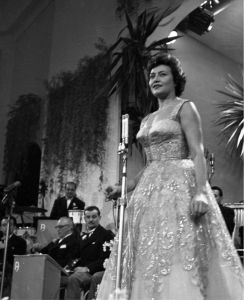 The success of the initiative was also due to Nizza's collaborator Mario Sogliano, who managed to obtain the support of the Casino's manager Busseti. The first
The success of the initiative was also due to Nizza's collaborator Mario Sogliano, who managed to obtain the support of the Casino's manager Busseti. The first 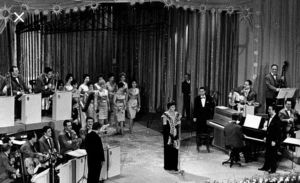 festival was organised thanks to the special interest of Giulio Razzi, then manager of the Turin State Radio Station, who contacted the various record companies, selected the best songs and invented the competition mechanism. The event, which lasted until 31 January, was presented by Nunzio Filogamo and accompanied by maestro Cinico Angelini's orchestra, and featured singers Nilla Pizzi and Achille Togliani with the vocal duo Fasano, who sang twenty songs chosen from a shortlist of 240 submitted by as many Italian authors.
festival was organised thanks to the special interest of Giulio Razzi, then manager of the Turin State Radio Station, who contacted the various record companies, selected the best songs and invented the competition mechanism. The event, which lasted until 31 January, was presented by Nunzio Filogamo and accompanied by maestro Cinico Angelini's orchestra, and featured singers Nilla Pizzi and Achille Togliani with the vocal duo Fasano, who sang twenty songs chosen from a shortlist of 240 submitted by as many Italian authors.
In May 1951, local elections were held, which once again saw the victory of the Christian Democrat list, whose leading member Giovanni Asquasciati, former deputy mayor in the Gismondi administration, obtained the highest number of preferential votes with 1,403 preferences out of 21,841 voters. The floriculturists also took part in the election with their own list called 'Sole e Fiori', which was well received with 1,859 votes.
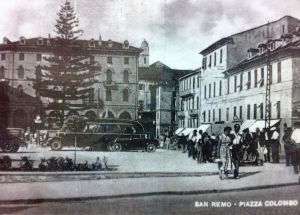 The new council elected Asquasciati as mayor, who formed a council of five full councillors and two deputy councillors. During the first months of the Asquasciati administration, work continued on the reconstruction of Piazza Colombo, divided into six lots, which the Asquasciati council then transformed
The new council elected Asquasciati as mayor, who formed a council of five full councillors and two deputy councillors. During the first months of the Asquasciati administration, work continued on the reconstruction of Piazza Colombo, divided into six lots, which the Asquasciati council then transformed 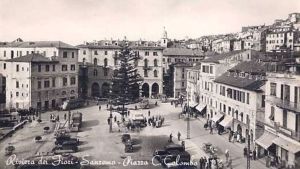 into a slab that would be used for years as a car park in the upper part and a bus park in the lower part.
into a slab that would be used for years as a car park in the upper part and a bus park in the lower part.
At the end of 1951, the Municipal Administration also appointed a Commission to draw up a building regulation updated in accordance with the latest urban planning trends, which would act as a barrier to the numerous buildings that were springing up all over the place in a disorderly fashion due to the lack of a plan.
Engineer Morando was appointed rapporteur for the Commission and, after two years of intense work, completed the text of the regulation, which was then sent to the Ministry of Works in Rome, where it was returned to the municipality on 10 April 1953, practically approved in all its parts.
In the meantime, another tragedy occurred in connection with the Casino. In fact, a few days after the second edition of the Festival, Pier Busseti, manager of the Sanremo gaming house, suffered a sudden heart attack on the afternoon of 17 February 1952 in his home in Via Lima in Rome. In spite of the immediate treatment he received from renowned clinicians, including Professors Frugoni, Episcopo and Sebastiani, his heart stopped beating late in the evening two days later due to cardiovascular collapse.
Although the official version of the death is said to have been caused by illness, rumours have also been circulating « that the entrepreneur had supposedly committed suicide because of his company's precarious financial situation. It has also been suggested that there is a possible link between his death and the drug trafficking between the United States and Italy run by Cosa Nostra, and in particular by the Italo-American boss Lucky Luciano. Accurate investigations carried out by the Police and the Guardia di Finanza have not, however, made it possible to ascertain the truth of these rumours ». (article by Andrea Gandolfo in 'Gardiöra du Matüssian', no. 1, 2018)
After Busseti's death, the management of the Casino was entrusted to the Milanese industrialist Rinaldo Masseroni.
In 1953, Aristide Vacchino, son of Carlo Vacchino, who had already managed the theatre "Principe Amedeo" and the "Cinema Teatro Centrale", signed a contract with the construction company Marchetti & Co. Spa to build the brand new "Centro Ariston".
The project, strongly desired by Aristide, came to life following the bombings that destroyed the "Principe Amedeo" theatre, located in Piazza Borea D'Olmo at the time.
Aristide then expressed the need to rebuild a theatre worthy of the name for his Sanremo. In the area of the former "Principe Amedeo", he built "Il Giardino" (the Garden), a large open-air cinema.
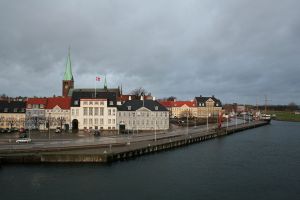 In February 1953 the City Council also decided to twin Sanremo with the Danish city of Helsingør (Helsinore in Italian), a place known throughout the world because it is the setting for William Shakespeare's Hamlet.
In February 1953 the City Council also decided to twin Sanremo with the Danish city of Helsingør (Helsinore in Italian), a place known throughout the world because it is the setting for William Shakespeare's Hamlet.
The official twinning ceremony, which at first was preferred to be called a pact of brotherhood, was then held in Denmark in the presence of the Danish authorities, the mayor Asquasciati and some councillors and councillors from Sanremo representing the municipality.
In the meantime, the abnormal building development of the city continued, its unstoppable march being favoured in every way by the councillor for public works and private construction, engineer Parodi, while the municipal administration planned the construction of the new fruit and vegetable market in the area opposite the Galleria Francia, at the beginning of Via Martiri della Libertà, at a total cost of 800 million euro.
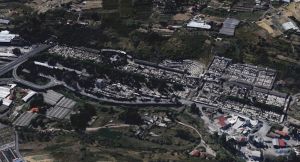
In Valle Armea, the new cemetery was inaugurated.
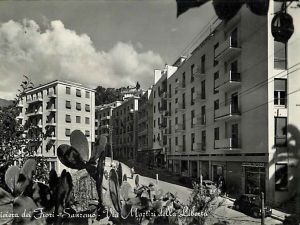
In the face of the disorderly proliferation of hundreds of new buildings, the Asquasciati Council was unable, however, to counterbalance it with an adequate regulatory plan capable of regulating this immense building growth, which took place without any planning and led to the construction of dozens and dozens of buildings and apartment blocks in Via Martiri della Libertà, Via Pietro Agosti, in 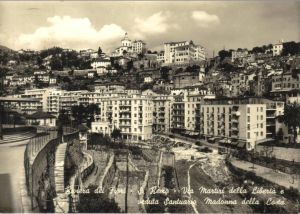 the centre of Marsaglia Park and in the Magnolia Park, which are a tangible sign of the building speculation that took place in San Remo from the early 1950s onwards.
the centre of Marsaglia Park and in the Magnolia Park, which are a tangible sign of the building speculation that took place in San Remo from the early 1950s onwards.
And all this in spite of the fact that in 1953 the Ministry of Public Works had ordered the Municipality of Sanremo to draw up a new urban development plan, which was made executive in 1957 following ministerial approval, but was not put into practice, remaining only at the planning stage.
On 9 November 1954, a public auction was held in Palazzo Comunale to award the management of the Casino, which was won by the Milanese industrialist Masseroni, who, after taking over the management of the Casino after the tragic death of Busseti, had exercised his right of pre-emption by offering 73.01% of the gross takings to the Municipality. Masseroni then began managing the Casino, assisted by valuable collaborators such as bank officer Diomede Turitto, Tagliabue and Angelo Amato.
In the early 1950s, the government had also launched the so-called 'blue plan', which envisaged substantial public funding for Italian ports, including San Remo.
At that time, Mayor Asquasciati summoned to the Town Hall the representatives of the bodies interested in the port area, telling them that the port project, already planned in 1950 and carefully followed by the local parliamentarians, had induced Minister of the Merchant Marine Cappa to classify the port of Sanremo among those of "considerable tourist interest". (for more information see the History of the Port).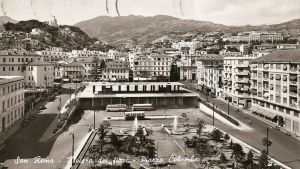 On 8 March 1956, after three years of work, the bus station in Piazza Colombo was inaugurated in the presence of the Minister of Transport Angelini, an important public work strongly desired by Mayor Asquasciati and costing a total of 230 million lire.
On 8 March 1956, after three years of work, the bus station in Piazza Colombo was inaugurated in the presence of the Minister of Transport Angelini, an important public work strongly desired by Mayor Asquasciati and costing a total of 230 million lire.
On the 21st of the same month, the village of Coldirodi, which at that time depended on Ospedaletti, was annexed to the Municipality of Sanremo, thus becoming a new hamlet of the Matuzian town, in execution of the decree issued by the President of the Republic, Giovanni Gronchi.
In May 1956, a new election was held, which again saw the affirmation of the DC, and in particular of the mayor Asquasciati, who obtained 3,826 preferences, followed immediately by the lawyer Nino Bobba, leader of an independent list called "Campanile".
The latter had achieved considerable success with nine elected councillors against the sixteen Christian Democrats and five Communists. After the ballot box results it became clear that the independents were the key to forming a solid majority in the municipal council and negotiations began between the DC and the 'Campanile' to find an agreement.
Having failed to reach an agreement, the Christian Democrats were forced to create a minority council made up only of members of their own party, supported from outside by the Social Democrats and the MSIs, who had formed the Democratic Bloc. On 27 June, Asquasciati was finally confirmed as mayor, while the independents of the 'Campanile' left the council chamber in protest.
The new Council, chaired by Asquasciati, who also took on the role of councillor for Tourism, was then formed by Sebastiano Elena, as deputy mayor and councillor for Floriculture, Guido Pancotti for Public Works, Francesco Bronda for Hygiene and Health, Francesco Viale for Work and Hamlets, Eraldo Cugge for Finance, Francesco Fusaro for Litigation, Giorgio Baldi for Heritage and Igino De Mori for Urban Police.
On 17 December 1956, a group of people from Sanremo, meeting at the Civic Library in Via Morardo, laid the foundations for the constitution of the "Famija Sanremasca", which, in the intentions of the promoters, was to be formed by two sections: one for historical studies, customs and traditions, and the other for folkloric events. The promoters of the new association included Stefano Canepa, Giorgio Baldi, Arturo Bacherini, Franco Forneris, Emilio Bosso, Giuseppe Ferrari, Mario Feroldi, Antonio Moretti, Antonio Maccario, Mario Carasi and Iolanda Lazzarini.
On 15 April 1957, the founding act of the association was drawn up in the presence of notary Giacomo Birone. The first president of the Famija Sanremasca would be Giuseppe Ferrari and vice-presidents Franco Forneris and Ersilio Bosso.
In the meantime, while rumours of a possible merger with the socialists were circulating, the social democrats withdrew their external support for the Asquasciati council, which however still held out until, on 25 July 1957, there was a government reshuffle with the independent councillors of the "Campanile" joining the majority. The new Council that emerged was made up of Mayor Giovanni Asquasciati, Guido Pancotti, Vice-Mayor and Councillor for Public Works, Eraldo Cugge for Finance, Carlo Bensa for Litigation, Paride Goya for State Property and Tourist Facilities, Angelo Trovati for the Annona, Vincenzo De Mori for Roads, and Francesco Bronda for Hygiene.
Before the reshuffle, the councillor for Tourism, Adriano Morosetti, had resigned unexpectedly in March because of the council's decision to spend 18 million to build a music auditorium in the centre of Marsaglia Park.
On 28 March 1957, the City Council also approved a new convention with the ATA, the company that managed the Casino and was directed by Masseroni, whose management, according to the intentions of the city administrators, was to continue until 9 April 1964.
The following 24 November, however, Masseroni unexpectedly died of a heart attack. The Municipal Administration then decided to renew its trust in the ATA, which was however entrusted to the lawyer Achille Cajafa.
In the course of 1958, relations between the DC and the "Campanile" soured even further. When the annual budget was approved, the latter issued a veritable ultimatum demanding that the document include matters relating to the flower market, the Imperatrice baths, a different arrangement for the Santa Tecla prisons, the hospital and the roads.
In May 1958 the Municipal Council, held up amidst ever-increasing difficulties, approved the project for the new flower market in the Carmelite Park in Corso Cavallotti, but it was never to be built because of pressure from all those in favour of saving the garden.
On 15 January 1959, the lawyer Cajafa died in a car accident in Serravalle Scrivia, continuing the series of deaths at the Casino, and was replaced at the head of ATA by the lawyer Luigi Bertolini, who had previously managed the Casino's restaurant.
Also in January 1959, the Municipality's Registry Office was equipped with a modern mechanical system designed to streamline the transcription of those entered in the population registers.
In June 1959 the Mayor Prof. Giovanni Asquasciati went, with a large delegation of fellow citizens, even in a special train, to Helsinore, the Danish city native land of Hamlet (which, we remind you, since February 1953 is twinned with Sanremo), to participate in the celebrations organised by that city. In the absence of the first citizen, strong contrasts emerged in the Municipal Council between Christian Democrat exponents and those of the "Campanile" list, with its 9 municipal councillors. In fact, on 25 June 1959, three independent councillors announced their resignations, which led to a crisis in the municipal administration.
The minority council groups (Socialists, Communists and MSIs), taking advantage of the disagreements that had emerged, declared their willingness to support a new council made up only of independents, completely excluding the Christian Democrats.
The councillors of the 'Campanile' promptly accepted the invitation and approved a new council, appointing the lawyer Carlo Bensa as the new mayor, dividing the aldermen between the various components.
In the meantime, Mayor Asquasciati returned to his office and called a meeting of the City Council for 9 July to discuss the motion of no-confidence presented by the various council groups.
At the opening of the meeting, Giovanni Asquasciati announced that he had no intention of resigning. The motion was put to the vote with 21 votes in favour and 19 against.
The twenty-one councillors of the new majority then asked Mayor Asquasciati to reconvene the Municipal Council within ten days to discuss a series of administrative matters.
In the meantime, opposing factions were unleashed on the city, accusing each other of the ineligibility of municipal councillors and of serious conflicts of interest, supported by furious press campaigns. On 27 July, a convulsive session of the municipal council took place, during which the mayor left the council chamber in protest, amidst lively protests from councillors opposed to him.
The following morning the representatives of the new majority were received by the Prefect of Imperia Vittorio Passananti. The government representative took note of what had been explained to him and hoped that a solution would be found as soon as possible in the interests of the city, through contacts between the two factions.
On the afternoon of 17 August, the council group and the Sanremo municipal committee of the DC met at the party headquarters, where, after listening to Senator Zaccari's report, they decided to invite Mayor Asquasciati and the councillors still in office to resign at the municipal council meeting on 20 August.
As a result of this decision, the mayor sent a letter to all councillors informing them that they would only have to 'take note' of their resignation at the forthcoming session of the municipal assembly. On the evening of 20 August, in front of a large and attentive audience, the council then discussed the resignation of the Asquasciati council.
Before taking the floor to officially announce his departure, the mayor read out a brief statement, in which he claimed credit for the work he and his group had done to address the many issues facing the city and lamented the method used by the new majority to force him out of office. The vote on the motion of no-confidence was passed with 20 votes in favour, 17 blank ballots and one abstention.
This resolution formally opened the crisis in the municipal administration, so much so that another municipal council was to be convened on 27 August to appoint a new mayor.
After an attempt, proposed by some councillors, to create a Council with a division between the various groups but with the exclusion of the ex-mayor, which was rejected by the Christian Democrats, on the evening of 29th August 1959 the new mayor of Sanremo was elected with twenty-one votes in favour, against seventeen votes going to the ex-mayor Asquasciati, the social democrat Secondo Anfossi, who, as soon as he took office, declared: « The programme of my administration will be based on honesty, for which I will do my utmost to respect ».
After the election of the first citizen, the municipal council proceeded to appoint the councillors and deputies. Five full councillors were elected, all from the independent group, and one from the Movimento Unitario di Iniziativa Socialista. The alternate councillors were one from the Italian Socialist Party and one from the Independence Party. Immediately afterwards, the leader of the new majority Vincenzo Semeria extended his warmest greetings to the newly elected mayor, wishing him a fruitful administrative activity in the exclusive interest of the city and its inhabitants. Semeria's words were joined by those of the leader of the DC group, Francesco Fusaro, who, after wishing the newly elected Mayor all the best, drew the attention of all present to the remarkable work carried out by Mayor Asquasciati during his eight years of administration.
The Anfossi administration would then govern the town until 9 June 1960, when the social-democratic senator died in Taggia, where he had been living for some time.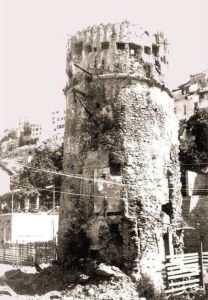 In December 1959, the structure of the Mercato Annonario was finished and the surrounding square was about to be levelled and asphalted.
In December 1959, the structure of the Mercato Annonario was finished and the surrounding square was about to be levelled and asphalted.
On the evening of 2 December 1959, Councillor Baldi, together with a group of people, was passing through Via Martiri della Libertà at about 11 p.m., just as a team of workers, around an excavator machine to which a large iron ball had been attached, was striking the historic Bastione della Ciapéla (commonly known as the "Saracen Tower") with violent blows, with the evident intention of pulling it down.
After several citizens had come between the machine and the Tower, protesting, Dr Baldi, who at that time was an opposition councillor, turned to the police, prompting the intervention of Deputy Commissioner Dr Molinari and a team of officers, who ordered the workers to stop work. 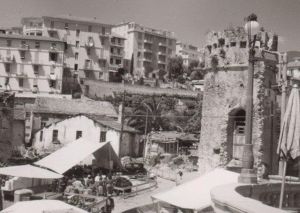 The team of workers was employed by Mr Lombardi, of the Municipal Technical Office, who informed the police that he was doing his duty.
The team of workers was employed by Mr Lombardi, of the Municipal Technical Office, who informed the police that he was doing his duty.
However, the demolition "work" was suspended, but the investigations continued until Mr Lombardi and Mr Domenico Parodi, then councillor for public works, were charged with damage.
The trial was held in the Magistrate's Court. Mr Parodi and Mr Lombardi declared that the then Administration, headed by Senator Secondo Anfossi, had passed a regular resolution ordering the demolition of the Saracen tower. The judge granted general extenuating circumstances and the benefits of the law on the four-month prison sentence imposed on each of the defendants, and ordered both to pay court costs and compensation for damages to civil parties.
The rescue of this historical monument was also due to the intervention of Sanremo associations and above all to two authoritative local personalities, the painter Alberto Carlo and the writer Giuseppe 'Pipin' Ferrari.
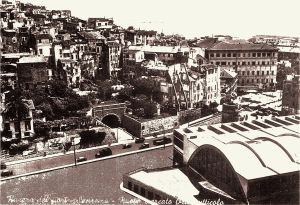 In January 1960 the private clinic Villa Athena and the new fruit and vegetable market in "piazza Eroi Sanremesi" were inaugurated, to access which in July 1963 the Galleria Francia, which had served as an air-raid shelter during the war, was opened to traffic.
In January 1960 the private clinic Villa Athena and the new fruit and vegetable market in "piazza Eroi Sanremesi" were inaugurated, to access which in July 1963 the Galleria Francia, which had served as an air-raid shelter during the war, was opened to traffic.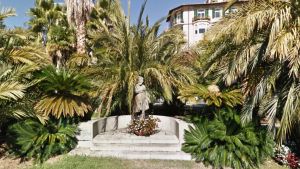
In the same period, the monument to the well-known lawyer and socialist deputy Orazio Raimondo from Sanremo was also inaugurated, placed in Corso Salvo D'Acquisto in front of the Morgana bathing establishment.
A few months later, on 9 June 1960, in the same year in which the social-democratic mayor Anfossi died in Taggia, the councillor for tourism Morosetti, also a social-democrat, was declared disqualified as a municipal councillor because his company was accused of having carried out work on behalf of the municipality.
In reality, Morosetti's dismissal was the result of the fierce smear campaign waged against him by his political opponents.
A few days after this measure, on 23 June, Morosetti died suddenly of a collapse and with him disappeared from the political scene in Sanremo one of the protagonists of the recent history of the town, for which he had been councillor for Tourism for eight consecutive years, had invented the carnival and the flowered course and had been president of its football team.
Immediately after Morosetti's death, the municipal administration entered a crisis that was only resolved on 14 July, when Christian Democrat Francesco Fusaro was elected mayor with twenty-one votes in favour.
The following November, local elections were held, which once again saw the affirmation of the Christian Democrats, whose councillors formed a new majority together with the Social Democrats and the independents of 'Sole e Fiori', the list of flower growers.
The minority consisted of the Communists with six councillors, the Socialists with five councillors, the MSIs with three councillors and the Liberals with one councillor.
The new municipal council then reconfirmed Christian Democrat Fusaro as mayor. Shortly after Fusaro's re-election, councillor Giorgio Baldi resigned from his post, complaining that the DC council group was not united.
In the meantime, the council approved the new location of the Flower Market in Mordibue, but the market was never built.
In 1960, the works for the third lot of the port area were also contracted out to the Impresa Acquarone of Ventimiglia, at a total cost of 65 million lire, 15 million of which were borne by the municipality. The subsequent works, which were completed at the end of 1961, would have led to the extension of the western pier by another 35 metres, plus the quaying of about 100 metres at the back of the pier itself, as well as the lengthening of the eastern breakwater by about 250 metres in the direction of the first quadrant and with a hammerhead in the direction of the breakwater for an extension of about 50 metres. At the same time as these works, Domenico Bartolo's company completed the levelling of the pier's road surface at a cost of 5 million euro, the extension of the quay in front of the south face of the docks along the Pian di Nave area and the doubling of the road above.
In the summer of 1961 the attention of the municipal administrators and of the tourist operators was focused instead on an innovative town-planning project, prepared by the architect Camus and the engineer Santagostino and called Sanremo-Mare, which foresaw to take away more than 500,000 square metres of land from the sea in order to build an entire residential district, which, however, after two years of heated discussions, would remain only on paper.
In November 1961, the 'Famija Sanremasca' merged with the 'Comitato Arti e Tradizioni', founded by the painter and art expert Carlo Alberto.
In February 1962, on the other hand, the president of the Tourist Board, Giovanni Bertalli, resigned and was replaced by Dr. Mario Massobrio, who took over the reins of the Tourist Board after the interlude of the prefect Bartolomeo Marco as commissioner.
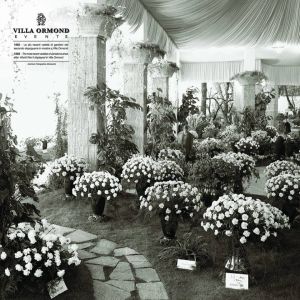 From 1 to 11 of following March, the International Flower Show was held in the Villa Ormond area, which was extended to include the Magnolia and Nobel gardens and covered a total area of 50,000 square metres.
From 1 to 11 of following March, the International Flower Show was held in the Villa Ormond area, which was extended to include the Magnolia and Nobel gardens and covered a total area of 50,000 square metres.
The Exhibition, organised by Dr Mescola and lawyer Bobba, saw the participation of the most important national flower producers, who presented thousands of different varieties of flowers. The jury had Domenico Aicardi as honorary president and Commendatore Giuseppe Ratti, who had organised the previous year's International Flor '61 Exhibition in Turin, as acting president.
The exhibition also included a scientific congress on carnation cultivation organised by the Società Orticola Italiana.
In the winter of 1962, meanwhile, deputy mayor Francesco Viale went to Rome to follow more closely the progress of several important projects, including the phantom new Flower Market in Mordibue (Via San Francesco), the relocation of the railway line upstream and the widening of the subway in Via del Castillo.
Afterwards, the finance councillor Eraldo Cugge presented the council with the municipal budget for 1962, which, based on the expected revenue from the Casino, amounting to 3 billion lire, and on the taking out of a number of loans for public works, was expected to break even through a loan of one billion lire. The budget for 1962 was approved by the City Council.
On 21 April 1962 the Council unanimously voted to trust Luigi Bertolini with the management of the Casino and at the same time decided to set up a Commission to agree with the ATA on the clauses of the contract for the renewal of the management of the Casino. However, the MSI councillors Roberto Moroni and Bruno Tamponi, the communist Franco Dulbecco and the socialist Silvio Dian expressed their opposition to this decision, asking, to no avail, that members of the Commission in charge of negotiating with the concessionaire company also include members of the council minorities.
At the same time, Mayor Fusaro, Vice-Mayor Viale and Councillor for Tourism Goya went to Rome to negotiate with the government about the Casino. The government seemed to be oriented towards renewing the concession for another ten years, i.e. until spring 1973.
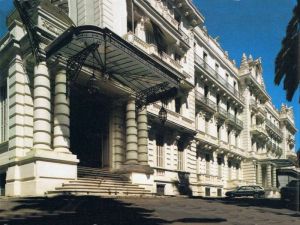 In the capital, the Sanremo administrators also negotiated the purchase of the Excelsior-Bellevue complex, chosen as the new seat of the Town
In the capital, the Sanremo administrators also negotiated the purchase of the Excelsior-Bellevue complex, chosen as the new seat of the Town 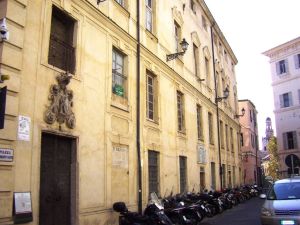 Council (which was previously in Palazzo Nota), the financing of the flower market and the tourist port.
Council (which was previously in Palazzo Nota), the financing of the flower market and the tourist port.
The purchase of Bellevue was then negotiated on the basis of 650 million lire, with Dr Felice Bertalli in charge.
In the meantime, the decision to reassign the management of the Casino to the ATA, a decision supported in particular by the leaders of the San Remo Socialist Party, led to the resignation of the town councillor Agostino Donzella for disagreement over the conduct of the negotiations.
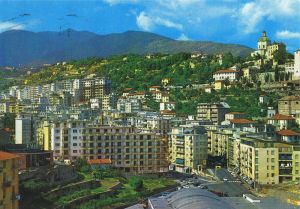 In the meantime the phenomenon of building development did not diminish in intensity (photo via martiri-agosti), which was radically transforming the face of the town; it was then calculated that only in the period between 1953 and 1960 44,596 rooms were built in Sanremo for a total of 1,377,880
In the meantime the phenomenon of building development did not diminish in intensity (photo via martiri-agosti), which was radically transforming the face of the town; it was then calculated that only in the period between 1953 and 1960 44,596 rooms were built in Sanremo for a total of 1,377,880 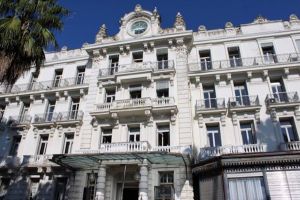 square metres, while in 1961 6,953 rooms were built for 208,590 square metres.
square metres, while in 1961 6,953 rooms were built for 208,590 square metres.
In April 1963, the City Council formalised the purchase of Palazzo Bellevue, which in 1966 would become the new headquarters of the Sanremo City Council.
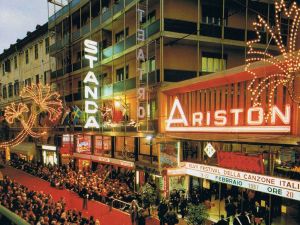 On the following 31st May, after ten years of work, the "Cinema Teatro Ariston" was inaugurated, the largest indoor theatre in the region, with 1960 seats,
On the following 31st May, after ten years of work, the "Cinema Teatro Ariston" was inaugurated, the largest indoor theatre in the region, with 1960 seats, 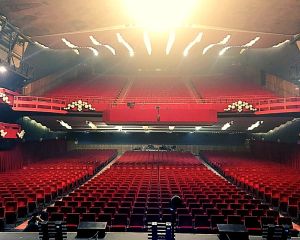 divided between stalls and gallery, with sixteen boxes. For the occasion, the film 'Mutiny on the Bounty' was shown, preceded by an opera concert conducted by Carlo Farina.
divided between stalls and gallery, with sixteen boxes. For the occasion, the film 'Mutiny on the Bounty' was shown, preceded by an opera concert conducted by Carlo Farina.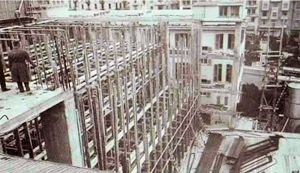
The new structure was built on the initiative of the Sanremo cinema entrepreneur Aristide Vacchino, who had already created the "Centro Ariston" in 1953 with the opening of the "Giardino" cinema in the square formed after the destruction of the "Principe Amedeo" theatre.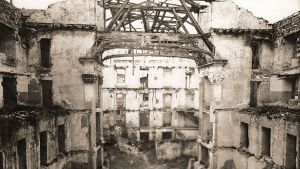
At the same time the Cinema Ariston Mignon was opened, which, inaugurated in early December 1962, would later take the name Cinema Ritz.
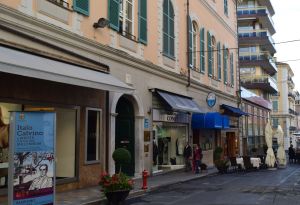 In 1963 the Municipal Administration decided to transfer the Civic Library (photo) from its seat (created in 1901 in the upper premises of the former
In 1963 the Municipal Administration decided to transfer the Civic Library (photo) from its seat (created in 1901 in the upper premises of the former 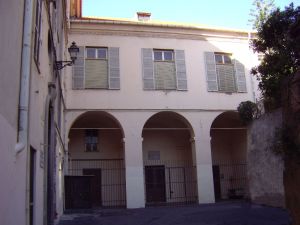 Annunziata in via Morardo) to the first and second floors of the nineteenth-century building owned by the "Asilo Corradi" institution in Via Carli, where it is currently located. The enormous patrimony of works from the 16th, 17th and 18th centuries belonging to the ancient library of the Capuchin friars was naturally transferred to the library, with bibliographic donations from Dr. Francesco Corradi and later, thanks to the work of the coordinator Dr. G.B. Barboro (1864 - 1938) enriched with new works from the existing collection and donations from private individuals.
Annunziata in via Morardo) to the first and second floors of the nineteenth-century building owned by the "Asilo Corradi" institution in Via Carli, where it is currently located. The enormous patrimony of works from the 16th, 17th and 18th centuries belonging to the ancient library of the Capuchin friars was naturally transferred to the library, with bibliographic donations from Dr. Francesco Corradi and later, thanks to the work of the coordinator Dr. G.B. Barboro (1864 - 1938) enriched with new works from the existing collection and donations from private individuals.
On 23rd December 1962 the Cinema Orfeo was inaugurated in the Foce Region, along Corso Matuzia, which was later taken over by the Vacchino company.
In 1963 there was also a stormy meeting of the Municipal Council, held immediately before the tender for the assignment of the new management of the Casino, during which the Christian Democrat mayor Fusaro announced that he had denounced three of his party colleagues to the judicial authorities for the pressure they had exerted on him to renew the concession of the Casino to the lawyer Bertolini.
The three suspects would then be tried in the magistrates' court for the offence of bid-rigging.
The next auction for the assignment of the new concession for the Casino was won by Bertolini's ATA, which had offered 83.20% of the gross revenue to the Municipality.
In December 1963 the Fusaro Council entered a crisis with the resignation of all eight councillors, but despite this the mayor made it known publicly that he would not resign, at least until March of the following year.
In February 1964, Fusaro presented himself in the City Council as the only resigning member of his Council and, unexpectedly, the councillors, among whom there were a number of "free shooters", renewed their confidence in him.
In March, however, Fusaro, noting that his council had practically dissolved, withdrew his candidature and the Christian Democrat professor Eraldo Cugge was elected in his place.
In November 1964, local elections were held, which also saw the participation of two independent lists: "Sole e Fiori" and "Il Faro".
After the elections, which had once again seen the DC assert itself as the party with the relative majority, the Christian Democrat councillors tried to get Giovanni Asquasciati elected mayor, but he was defeated by only twenty votes, partly due to the presence of many "free shooters", and would later retire permanently from political life.
Professor Cugge was then re-elected as mayor, and launched a centre-left council, made up of a Socialist as deputy mayor, a Social Democrat as Tourism, an Independent as Floriculture, and three Christian Democrats as Public Works, Finance and Urban Police. The Municipal Council was then composed of fifteen Christian Democrat councillors, eight Communists, four Liberals, three Faro members, three Social Democrats, three Socialists, two members of the "Sole e Fiori" party and two MSI members.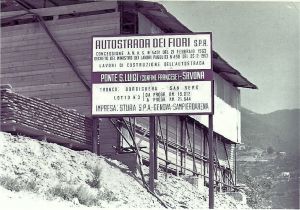
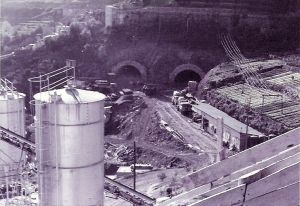 On 12 February 1965, work began on the construction of the Autostrada dei Fiori, an important road that would have been a valid alternative to the Aurelia, which was beginning to be too congested with traffic, especially heavy vehicles.
On 12 February 1965, work began on the construction of the Autostrada dei Fiori, an important road that would have been a valid alternative to the Aurelia, which was beginning to be too congested with traffic, especially heavy vehicles.
The following October, the DC national leadership decided to commission the Sanremo sections of the party, sending the lawyer Antonio Avezzu to Sanremo as extraordinary commissioner.
In the same month, the president of the Tourist Board, Mario Massobrio, a Christian Democrat, decided to resign from his post for political reasons.
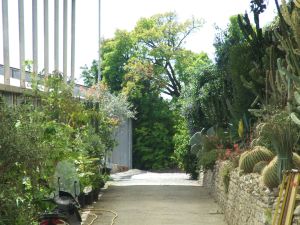 Also in October 1965, a new secondary school specialising in floriculture was founded in the city, the "Domenico Aicardi" Professional Institute (photo), which gave young people the opportunity to learn about floriculture on a scientific basis.
Also in October 1965, a new secondary school specialising in floriculture was founded in the city, the "Domenico Aicardi" Professional Institute (photo), which gave young people the opportunity to learn about floriculture on a scientific basis.
The following November, the deputy mayor Silvio Dian also resigned and was replaced in early January 1966 by the engineer Giancarlo Del Gratta.
During 1966 the Council also approved the projects for the car park at the Flower Market (photo) and the railway subway near the Post Office, in order to connect the city centre to the port area.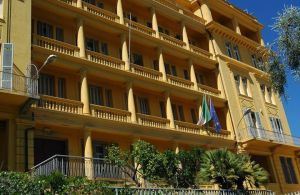
1966 saw the relocation of the headquarters of the historic Classical Lyceum "Giandomenico Cassini" from the old building in Piazza Cassini to the annex of the Hotel Excelsior-Bellevue in the green gardens of Corso Cavallotti.
At the beginning of 1967 the general manager of the Casino, Diomede Turitto, resigned, while on 15 January Professor Cugge announced his resignation as mayor in accordance with the directives of the party, which had imposed an internal change.
Commissioner Avezzu, in fact, in order to put an end to the administrative stalemate caused by Cugge's management of the Municipality, had decided to entrust the civic administration to a young and dynamic mayor, in the person of the lawyer Francesco Viale, who had already been deputy mayor in the previous council and had also obtained the highest number of preferences in the last municipal elections.
On February 2, 1967 Viale was elected mayor by the City Council, which had met for the first time in the ground floor room of Palazzo Bellevue, which from that moment on officially became the new seat of the Municipality of Sanremo.
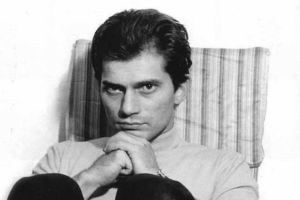 A tragic event characterised that year's edition of the Festival: the Genoese singer-songwriter Luigi Tenco (photo), upon hearing the news of his elimination from the singing competition, took his own life in a room of the Hotel Savoy, where he was staying; the news of Tenco's suicide would therefore have made a huge impression on public opinion, which was deeply shocked by the gesture made by the Genoese singer-songwriter.
A tragic event characterised that year's edition of the Festival: the Genoese singer-songwriter Luigi Tenco (photo), upon hearing the news of his elimination from the singing competition, took his own life in a room of the Hotel Savoy, where he was staying; the news of Tenco's suicide would therefore have made a huge impression on public opinion, which was deeply shocked by the gesture made by the Genoese singer-songwriter.
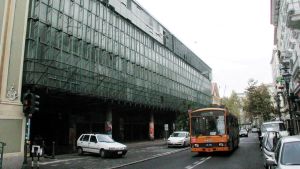
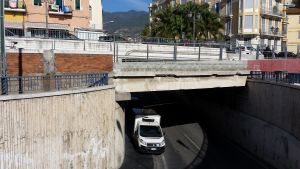 In the following months, the Viale administration carried out some important public works, such as the car park of the Flower Market in Corso Garibaldi and the subway of the Post Office.
In the following months, the Viale administration carried out some important public works, such as the car park of the Flower Market in Corso Garibaldi and the subway of the Post Office.
In September 1967 the City Council unanimously voted to renew the concession of the Casino for another five years to Bertolini's ATA, but immediately afterwards the Minister of the Interior, Franco Restivo, established the definitive expulsion of the ATA from the Casino, despite the entry into the company of the Roman organiser Ezio Radaelli, who had bought a good part of the ATA shares.
After the ministerial intervention it seemed that ATA was destined to go bankrupt, but the Viale Council decided that Bertolini's company would continue to manage the Casino until 15 February 1969.
At the beginning of January 1968, the president of the Tourist Board, Rinaldo Ferrero, bought Villa Nobel in Corso Cavallotti, where the great scientist had died, for one hundred million lire, which was then definitively taken over by the Provincial Administration of Imperia in 1973.
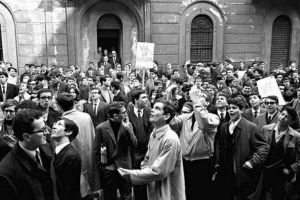 In 1968, Sanremo too witnessed numerous episodes linked to the phenomenon of youth protest, which manifested itself above all in the city's schools. In November, upper secondary school students took to the streets to demand the abolition of the class school, the opening up of the university faculties of mathematics, political science and law to accountants, the introduction of a course in contemporary history, the elimination of the value of the vote, and the active participation of students in the drafting of curricula and the choice of textbooks.
In 1968, Sanremo too witnessed numerous episodes linked to the phenomenon of youth protest, which manifested itself above all in the city's schools. In November, upper secondary school students took to the streets to demand the abolition of the class school, the opening up of the university faculties of mathematics, political science and law to accountants, the introduction of a course in contemporary history, the elimination of the value of the vote, and the active participation of students in the drafting of curricula and the choice of textbooks.
However, the most serious episode of the protest took place on 14 December 1968 at the Ariston Theatre where the Benvenuti-Fullmer boxing match was being held. Numerous young protesters armed with artichokes and rotten eggs surrounded the ring and came into contact with the police officers present in the hall, who charged them, causing a series of scuffles which resulted in some minor injuries.
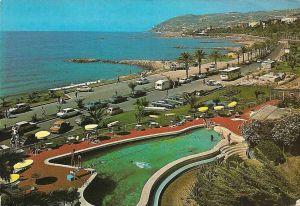 In September, meanwhile, the Viale administration had started work on the construction of the sea cliff between the Vittorio Veneto gardens and Corso Imperatrice, thus creating a new promenade that had been designed by an engineer employed by the Autostrada dei Fiori.
In September, meanwhile, the Viale administration had started work on the construction of the sea cliff between the Vittorio Veneto gardens and Corso Imperatrice, thus creating a new promenade that had been designed by an engineer employed by the Autostrada dei Fiori.
In February 1969, the youth protests also affected the Festival, which, after risking not being broadcast by RAI for fear of possible incidents, was then held regularly in a city guarded by hundreds of agents and carabinieri who had set up a protective cordon from Piazza Colombo to the Casino to prevent any demonstrative actions against the singing event.
On 16 February 1969, ATA, which had managed the Sanremo gaming house for sixteen years, finally left the scene and the town council appointed two commissioners to run the casino, one of whom, the president, was a prefect of the Republic appointed by the Minister of the Interior.
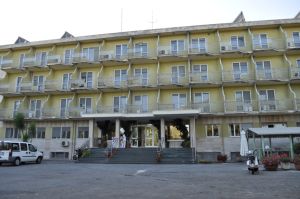 In April 1969, in the presence of Mayor Viale, Casa Serena was inaugurated on the Poggio hill, a modern structure designed to accommodate INPS pensioners. (photo)
In April 1969, in the presence of Mayor Viale, Casa Serena was inaugurated on the Poggio hill, a modern structure designed to accommodate INPS pensioners. (photo)
(based on the texts of "Storia della Città di Sanremo", "Storia Tascabile della Città di Sanremo" by Dr Andrea Gandolfo and other authors; images from personal archives or from the WEB)





